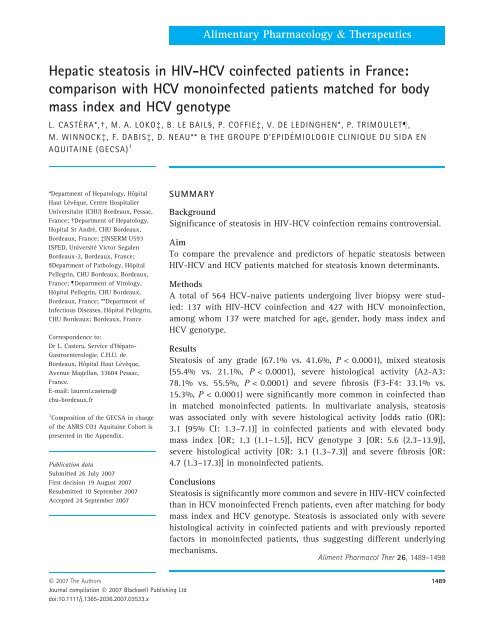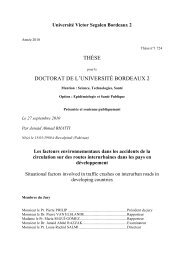Create successful ePaper yourself
Turn your PDF publications into a flip-book with our unique Google optimized e-Paper software.
Alimentary Pharmacology & Therapeutics<br />
Hepatic steatosis in HIV-HCV coinfected patients in France:<br />
comparison with HCV monoinfected patients matched for body<br />
mass index and HCV genotype<br />
L. CASTÉRA*, , M.A.LOKOà, B.LEBAIL§,P.COFFIEà, V. DE LEDINGHEN*, P. TRIMOULET–,<br />
M. WINNOCKà, F.DABISà, D. NEAU** & THE GROUPE D’EPIDÉMIOLOGIE CLINIQUE DU SIDA EN<br />
AQUITAINE (GECSA) 1<br />
*Department of Hepatology, Hôpital<br />
Haut Lévêque, Centre Hospitalier<br />
Universitaire (CHU) Bordeaux, Pessac,<br />
France; Department of Hepatology,<br />
Hopital St André, CHU Bordeaux,<br />
Bordeaux, France; àINSERM U593<br />
ISPED, Université Victor Sega<strong>le</strong>n<br />
Bordeaux-2, Bordeaux, France;<br />
§Department of Pathology, Hôpital<br />
Pel<strong>le</strong>grin, CHU Bordeaux, Bordeaux,<br />
France; –Department of Virology,<br />
Hôpital Pel<strong>le</strong>grin, CHU Bordeaux,<br />
Bordeaux, France; **Department of<br />
Infectious Diseases, Hôpital Pel<strong>le</strong>grin,<br />
CHU Bordeaux; Bordeaux, France<br />
Correspondence to:<br />
Dr L. Castera, Service d’Hépato-<br />
Gastroenterologie, C.H.U. de<br />
Bordeaux, Hôpital Haut Lévêque,<br />
Avenue Magellan, 33604 Pessac,<br />
France.<br />
E-mail: laurent.castera@<br />
chu-bordeaux.fr<br />
1 Composition of the GECSA in charge<br />
of the ANRS CO3 Aquitaine Cohort is<br />
presented in the Appendix.<br />
Publication data<br />
Submitted 26 July 2007<br />
First decision 19 August 2007<br />
Resubmitted 10 September 2007<br />
Accepted 24 September 2007<br />
SUMMARY<br />
Background<br />
Significance of steatosis in HIV-HCV coinfection remains controversial.<br />
Aim<br />
To compare the preva<strong>le</strong>nce and predictors of hepatic steatosis between<br />
HIV-HCV and HCV patients matched for steatosis known determinants.<br />
Methods<br />
A total of 564 HCV-naive patients undergoing liver biopsy were studied:<br />
137 with HIV-HCV coinfection and 427 with HCV monoinfection,<br />
among whom 137 were matched for age, gender, body mass index and<br />
HCV genotype.<br />
Results<br />
Steatosis of any grade (67.1% vs. 41.6%, P < 0.0001), mixed steatosis<br />
(55.4% vs. 21.1%, P < 0.0001), severe histological activity (A2-A3:<br />
78.1% vs. 55.5%, P < 0.0001) and severe fibrosis (F3-F4: 33.1% vs.<br />
15.3%, P < 0.0001) were significantly more common in coinfected than<br />
in matched monoinfected patients. In multivariate analysis, steatosis<br />
was associated only with severe histological activity [odds ratio (OR):<br />
3.1 (95% CI: 1.3–7.1)] in coinfected patients and with e<strong>le</strong>vated body<br />
mass index [OR; 1.3 (1.1–1.5)], HCV genotype 3 [OR: 5.6 (2.3–13.9)],<br />
severe histological activity [OR: 3.1 (1.3–7.3)] and severe fibrosis [OR:<br />
4.7 (1.3–17.3)] in monoinfected patients.<br />
Conclusions<br />
Steatosis is significantly more common and severe in HIV-HCV coinfected<br />
than in HCV monoinfected French patients, even after matching for body<br />
mass index and HCV genotype. Steatosis is associated only with severe<br />
histological activity in coinfected patients and with previously reported<br />
factors in monoinfected patients, thus suggesting different underlying<br />
mechanisms.<br />
Aliment Pharmacol Ther 26, 1489–1498<br />
ª 2007 The Authors 1489<br />
Journal compilation ª 2007 Blackwell Publishing Ltd<br />
doi:10.1111/j.1365-2036.2007.03533.x
















